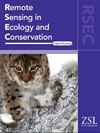Investigating boreal forest successional stages in Alaska and Northwest Canada using UAV‐LiDAR and RGB and a community detection network
IF 4.3
2区 环境科学与生态学
Q1 ECOLOGY
引用次数: 0
Abstract
Boreal forests are a key component of the global carbon cycle, forming North America's most extensive biome. Different successional stages in boreal forests have varying levels of ecological values and biodiversity, which in turn affect their functions. A knowledge gap remains concerning the present successional stages, their geographic patterns and possible successions. This study develops a novel application of UAV‐LiDAR and Red Green Blue (RGB) data and network analysis to enhance our understanding of boreal forest succession. Between 2022 and 2024, we collected UAV‐LiDAR and RGB data from 48 forested sites in Alaska and Northwest Canada to (i) identify present successional stages and (ii) deepen our understanding of successional trajectories. We first applied UAV‐derived spectral and structural tree attributes to classify individual trees into plant functional types representative of boreal forest succession, amely,利用无人机-激光雷达、RGB和社区探测网络对阿拉斯加和加拿大西北部的北方森林演替阶段进行了调查
北方森林是全球碳循环的关键组成部分,形成了北美最广泛的生物群落。不同演替阶段的北方森林具有不同程度的生态价值和生物多样性,从而影响其功能。关于目前演替阶段、它们的地理格局和可能演替的知识差距仍然存在。本研究开发了无人机-激光雷达和红绿蓝(RGB)数据和网络分析的新应用,以增强我们对北方森林演替的理解。在2022年至2024年间,我们收集了阿拉斯加和加拿大西北部48个森林站点的无人机- LiDAR和RGB数据,以(i)确定当前的演替阶段,(ii)加深我们对演替轨迹的理解。我们首先利用无人机衍生的光谱和结构树属性将单个树木划分为代表北方森林演替的植物功能类型,即常绿和落叶。其次,我们构建了森林-斑块网络来表征演替阶段及其相互作用,并评估了未来阶段的转变。最后,我们应用简化的正演模型来预测未来动态,并突出不同的演替轨迹。结果表明,在随机森林算法中,树高和光谱变量对植物功能类型的预测影响最大,总体精度较高。基于网络的群落检测算法揭示了5个相互关联的演替阶段,可以解释为早期演替到晚期演替和扰动阶段。受干扰地点主要分布在阿拉斯加内陆和中南部,而晚演替地点则主要分布在加拿大南部。过渡阶段主要位于冻土带-针叶林边界附近。这些发现突出了干扰的关键作用,如火灾或昆虫的爆发,在塑造阿拉斯加和加拿大西北部的森林演替。
本文章由计算机程序翻译,如有差异,请以英文原文为准。
求助全文
约1分钟内获得全文
求助全文
来源期刊

Remote Sensing in Ecology and Conservation
Earth and Planetary Sciences-Computers in Earth Sciences
CiteScore
9.80
自引率
5.50%
发文量
69
审稿时长
18 weeks
期刊介绍:
emote Sensing in Ecology and Conservation provides a forum for rapid, peer-reviewed publication of novel, multidisciplinary research at the interface between remote sensing science and ecology and conservation. The journal prioritizes findings that advance the scientific basis of ecology and conservation, promoting the development of remote-sensing based methods relevant to the management of land use and biological systems at all levels, from populations and species to ecosystems and biomes. The journal defines remote sensing in its broadest sense, including data acquisition by hand-held and fixed ground-based sensors, such as camera traps and acoustic recorders, and sensors on airplanes and satellites. The intended journal’s audience includes ecologists, conservation scientists, policy makers, managers of terrestrial and aquatic systems, remote sensing scientists, and students.
Remote Sensing in Ecology and Conservation is a fully open access journal from Wiley and the Zoological Society of London. Remote sensing has enormous potential as to provide information on the state of, and pressures on, biological diversity and ecosystem services, at multiple spatial and temporal scales. This new publication provides a forum for multidisciplinary research in remote sensing science, ecological research and conservation science.
 求助内容:
求助内容: 应助结果提醒方式:
应助结果提醒方式:


